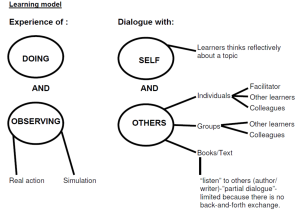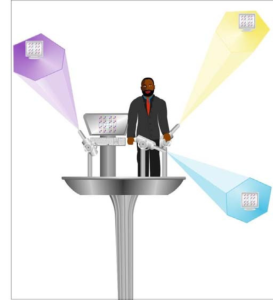| Learning Outcomes |
| · Active leading and participation take place in group learning situations.
· Responsibilities in the team are taken up and group work conventions are applied in learning situations. · Conflict management and negotiating techniques are practiced in diverse contexts. · Teamwork results in meaningful products, outcomes, or goals. |
- Introduction
In life, a good team has a better chance of getting to the top (achieving goals) than an individual has. It is therefore of great importance to be able to function well in a team (group). Group work aims to produce better (more effective, more detailed, more comprehensive) presentations and reports. This is achieved through the combined talents of group members, contributing knowledge and ideas.
One difficulty with group work is that you can’t work as quickly as you can by yourself. Patience, communication skills, and commitment are all required to make the most of the contributions of all group members. Thus, effective group work requires each member to focus on the process rather than just the product.
- Active participation
Active participation must take place in group learning situations
2.1 Meetings
In a meeting, two or more people come together to discuss a (usually) predetermined topic, such as business or community event planning, often in a formal setting.
In organizations, meetings are an important vehicle for, and personal contact with, human communication.
The reason for holding a meeting will determine what kind of meeting will be necessary:
| EXAMPLE |
| ♦ Status Meetings: Generally Leader-led, which are about reporting by one-way communication;
♦ Work Meetings: Which produce a product or intangible result such as a decision ♦ Staff meeting: Typically a meeting between a manager and those that report to the manager (possibly indirectly). ♦ Team meeting: A meeting among colleagues working on various aspects of a team project. ♦ Ad-hoc meeting: A meeting called together for a special purpose ♦ Management meeting: A meeting among managers ♦ Board meeting: A meeting of the Board of directors of an organization ♦ One to one meeting: A meeting between two individuals |
It is very important to make use of communication opportunities, especially those afforded at meetings, should you need to make a point, clarify your understanding, share information, etc. To do this, you need to participate actively, i.e. you need to play a constructive role in the meeting. Not only will you be imparting information, but you should learn (from various people) as well.
Site visits are planned and organized well in advance. They usually accommodate groups, to minimize disruption.
Site visits allow for:

Once again, it is important to use the opportunities to learn, by participating actively while on the site/field visit.
2.3 Excursions
An excursion is a trip by a group of people, usually made for leisure or educational purposes. It usually takes longer than a site/field visit but is less interactive. It consists mainly of observation. Excursions are, however, valuable learning tools, because one learns from the views and observations of other people.
An excursion is a trip by a group of people, usually made for leisure or educational purposes.
2.4 Discussions
A discussion is the examination of a matter in speech or writing. Here we are looking at a discussion in speech, more specifically a group discussion. As already stated, it is the examination of a matter, i.e. to investigate or discover facts about the matter. When this is done in a group, each member will give their own opinion and findings, thus disclosing varied points of view, from which one can learn. Active participation in the discussion is necessary for learning to take place.
2.5 Activities
This is the participation in specific tasks – often to practice a new skill or knowledge. When this is done in a group, it allows you to differentiate between positive and negative outcomes, thus affording more learning opportunities, provided you participate actively.
2.6 Workshops
A workshop is a gathering or training session that may be one day (or part thereof) or several days in length. It emphasizes problem-solving, and hands-on training, and requires the involvement of the participants. Often a symposium, lecture, or meeting can become a workshop when it is accompanied by a practical demonstration. Once again, this is an ideal opportunity to learn from others, be they, facilitators or peers.
- Responsibilities in the team
As mentioned earlier, group work has its problems, one of them being the unfair distribution of work and/or effort. It is therefore vital that all the members take turns and that the roles/responsibilities are rotated within the group.
It can be very frustrating in a group where one, or a few members, do all the work, leaving the rest as onlookers who do not get the opportunity to do their share. Equally frustrating is when one, or a few of the members, shirk their responsibility and choose to be ‘passengers’, leaving all the work to the rest of the group. In a test or examination situation, all the group members receive the same marks, which ends up being very unfair.
The three main roles which need to be rotated are:
♦ Conducting/chairing: This person leads or controls the meeting or group work situation. This is a very important role, as it can determine the outcome.
♦ Recording: This is an important role for two main reasons. Firstly, the recording has to be correct, because it is often referred back to for various reasons. Secondly, it forces the recorder to listen and concentrate, understand, and then reproduce the information.
♦ Reporting: The reporter has to relay the message/information in such a way that the listeners get all the necessary details, without repeating everything.
Taking turns and the rotation of the above roles gives everyone in the group equal learning opportunities.
- Conflict management and negotiating techniques
Conflict exists when there is a disagreement between two or more people because their perceptions of a situation are not the same. Many people feel that conflict must be avoided because it causes anger situations, but it does not only have negative or dysfunctional results. Conflict can also give rise to very positive or functional results. It is, however, very important that conflict is managed well in a defined context.
There is no one best way to deal with conflict. It depends on the current situation. Here are the major ways that people use to deal with conflict:
♦ Avoid it: Pretend it is not there or ignore it.
⇒ Use it when it simply is not worth the effort to argue. Usually, this approach tends to worsen the conflict over time.
♦ Accommodate it: Give in to others, sometimes to the extent that you compromise yourself.
⇒ Use this approach very sparingly and infrequently, for example in situations when you know that you will have another, more useful, approach very shortly. Usually, this approach tends to worsen the conflict over time and causes conflicts within yourself.
♦ Competing: Work to get your way, rather than clarifying and addressing the issue. Competitors love accommodators.
⇒ Use when you have a very strong conviction about your position.
♦ Compromising: Mutual give-and-take.
⇒ Use when the goal is to get past the issue and move on.
♦ Collaborating: Focus on working together.
⇒ Use when the goal is to meet as many current needs as possible by using mutual resources. This approach sometimes raises new mutual needs. Use when the goal is to cultivate ownership and commitment. Closely linked to conflict, we find negotiations. Negotiations happen all the time in our lives. We all want our way, but the person or people we are with also want their way – so you negotiate. To get what you want, you always have to do something in return or give up something.
“If I come shopping with you now, I’m watching soccer this afternoon.” “If I work over Christmas, can I have Easter off?” At work, negotiations are sometimes more serious and are generally entered into with the specific intention of bringing about a change in a situation – e.g. negotiating for higher wages or different work conditions.
Both parties generally have a very strong reason for wanting the situation to change or to stay the same – depending on which side they are on. The ideal result of negotiations should be a win-win situation, where although people have had to compromise, neither side feels that they have given up too much and gained too little.
Negotiating successfully requires equal amounts of skill, common sense, and compromise. Negotiations must be facilitated (led) by an unbiased chairman who does not stand to gain anything from the outcome. The chairman must be able to see all party’s points of view and constantly seek the middle ground.
4.1 Guidelines that should make the negotiation process less stressful and more successful:
♦ Don’t go into negotiations angry or aggressive. You will not be negotiating wisely and by antagonizing the other party/is, you can do your position harm.
♦ Know what you want to gain and what you are prepared to give up.
♦ Allow the other person to speak and listen to what they are saying. They too have their own needs and desires.
♦ Have a notebook with you so that you can write down points to remember. You might become so obsessed with having your say, that you will not be listening and could easily miss something important.
♦ If the negotiations are planned and everyone is given a warning, prepare your case. The better prepared you are, the stronger your case will be. You will feel more in control and you will be more likely to get what you want. If necessary, seek to advise from the experts.
♦ Depending on the situation, you might want to consult someone who knows the law or bookkeeping or whatever.
♦ Don’t makes accusations or be insulting.
♦ Don’t lose your temper. If you lose your temper, you give the other party power over you.
♦ If several of you are involved in the negotiations, you must choose a spokesperson who will do most of the talking. If it is wage negotiations, it could be your union representative.
♦ Before the negotiations take place, you must all meet to make sure that you share the same vision and want to achieve the same goal. You have to place your trust in your spokesperson, so choose them wisely.
- Teamwork results in meaningful products or outcomes
All work is always done with a goal in mind. The purpose of the activities that get done is to achieve that initial goal. Often the goal is nearly achieved, but not quite. This results in frustration and often despondency.
More often than not, the negative situation could have been avoided. Two key factors are:
♦ Reaching consensus: To reach consensus means to reach a general agreement (within the team). The whole team must be in agreement (even if negotiation has had to take place to bring it about), for the goal to be achieved. If there is no consensus, it means that the team members have different goals. If you do not agree with something, it isn’t easy to give your commitment. This will ultimately sink the team as far as the original goal goes. Remember, a strong team is a united team!
♦ Task completion: In soccer, we sometimes say a team can’t ‘finish’, or their ‘finishing skills’ are poor, when they get the ball within shooting range of the goal posts, but fail to shoot a goal. The whole team worked very hard, but they go away empty-handed.
So often a team works diligently and hard to achieve their goal, but right at the end, it all falls flat because a small detail or issue was left out. This can be the result of all the members of the team not reaching a consensus. A team that is in the agreement will be eager to achieve success and will see to it that everything necessary is done to do so.



 resources, so that you can select a relevant one:
resources, so that you can select a relevant one:
